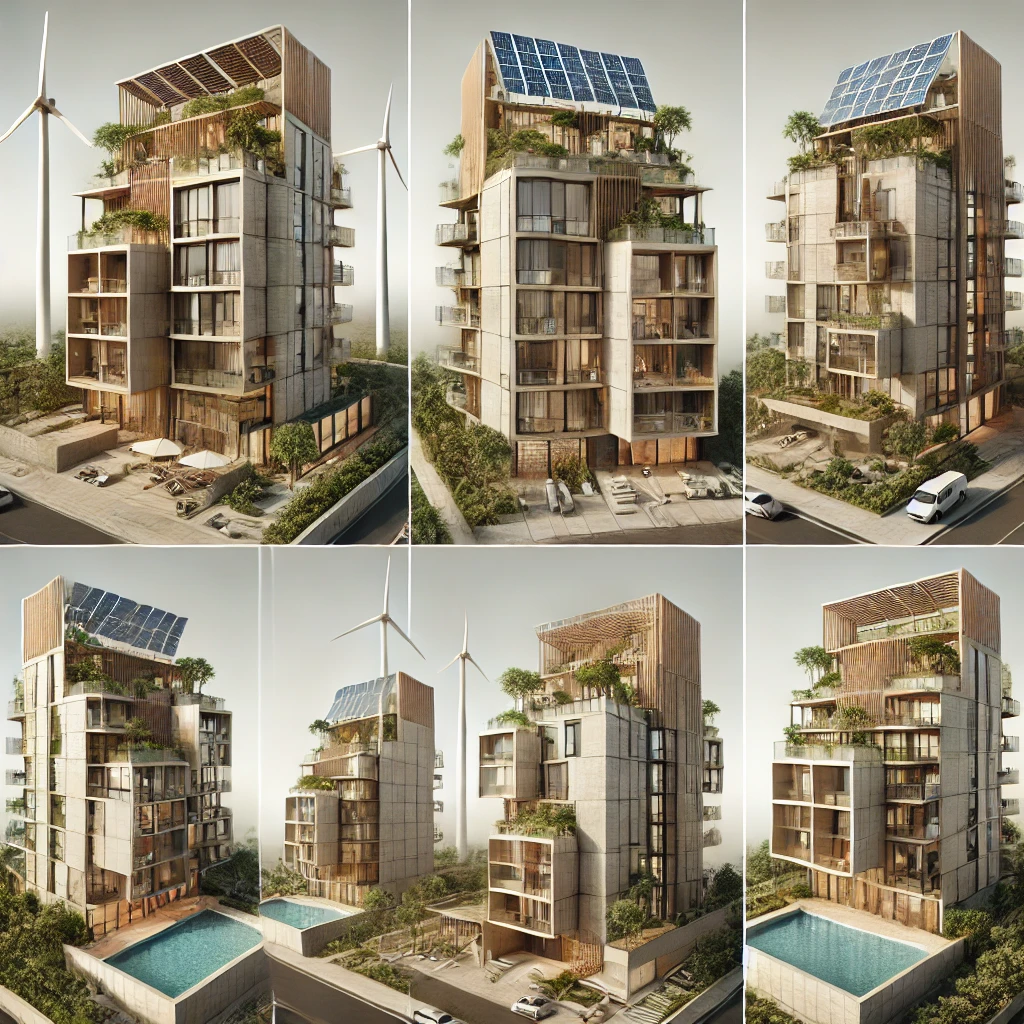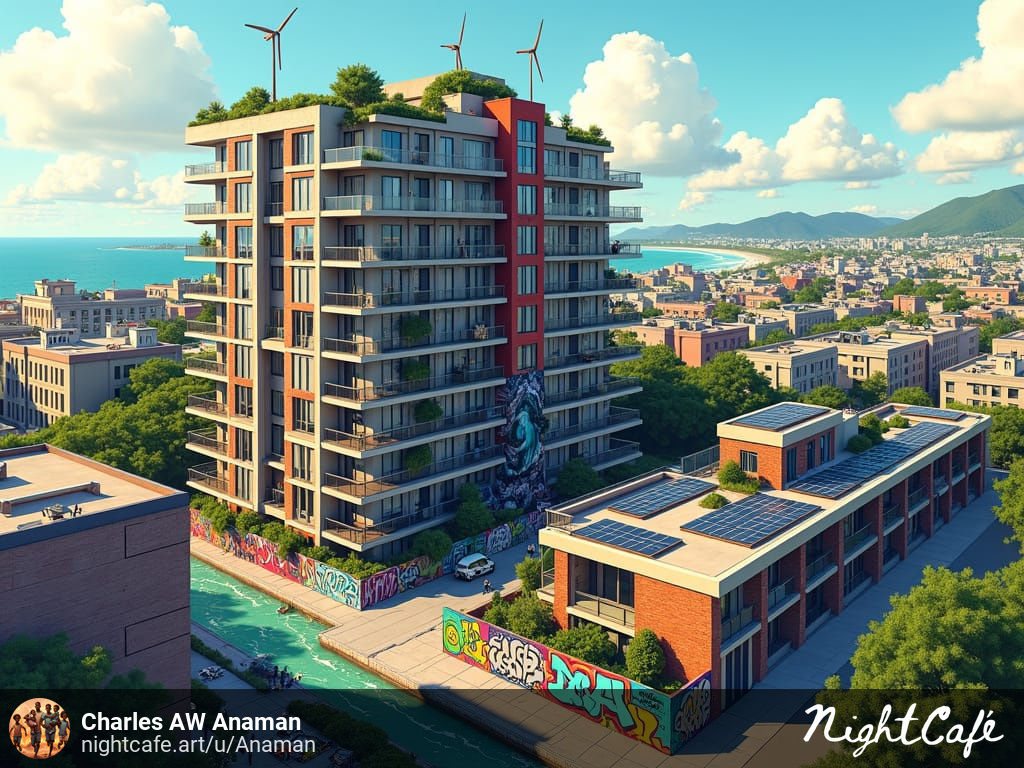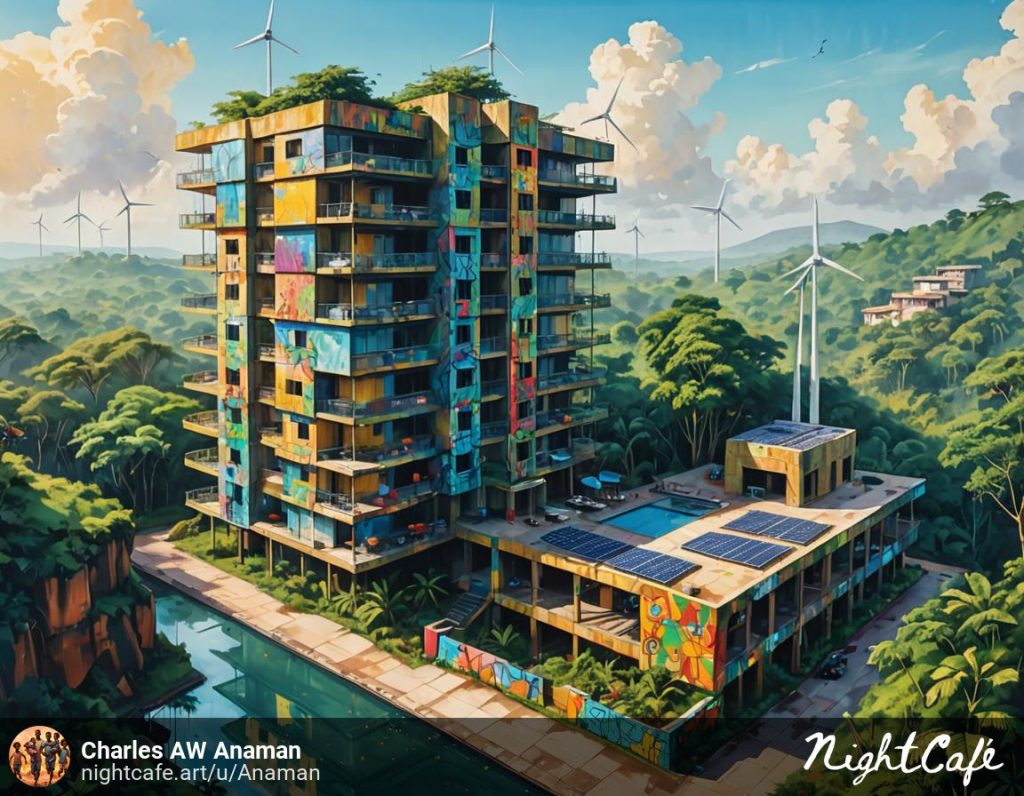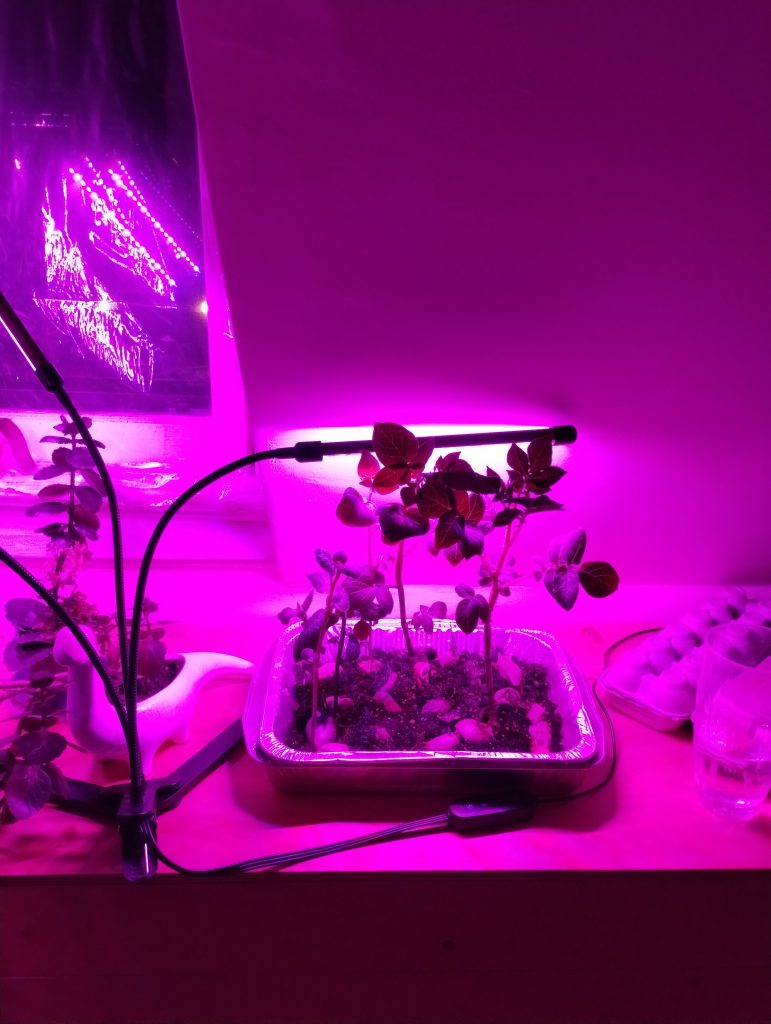Renewable energy solutions can be tailored to the unique characteristics of each location. By maximizing the use of rooftop solar panels, facade-integrated solar, small wind turbines, and micro-hydro systems, we can create sustainable and energy-efficient designs for Oregon, Western Accra, and Jinja.
In Oregon, prioritize south-facing roofs for solar panels and utilize the open landscape for wind turbines. For Accra and Jinja, consider solar shading structures, facade-integrated solar, and smaller wind turbines that suit the urban and natural settings. Micro-hydro systems near the Nile in Jinja, and rainwater harvesting systems in the tropical climates of Accra and Jinja, will further enhance the renewable energy capabilities of these locations.
By carefully incorporating these renewable energy solutions, we can develop comprehensive and convincing design guides that address the specific needs and characteristics of each region, ultimately leading to a more sustainable future.

2nd set of renderings

Accra\Wa Ghana Render

Interior Design Concept for a Renewable Energy Condo:
- General Layout:
- Open-Plan Living and Dining Area: Modern, spacious, with large windows for natural light. Integrated storage solutions, including built-in shelving and hidden storage compartments.
- Three Bedrooms:
- Master Bedroom: Includes a large walk-in closet with ample shelving and hanging space, plus an en-suite bathroom.
- Two Additional Bedrooms: Each with generous built-in closets that include both hanging and shelving options. Flexible-use rooms can also incorporate additional storage solutions such as under-bed storage or wall-mounted units.
- Modern Kitchen: Energy-efficient appliances, sustainable materials like recycled glass countertops, and abundant cabinet space, including a large pantry for food storage.
- Bathrooms: Eco-friendly fixtures, with storage cabinets under sinks and built-in shelves for towels and toiletries. The master bath features dual sinks and a walk-in shower.
- Common Room:
- Spacious with Large Windows: Maximizes natural light, includes a kitchenette, seating area, and children’s play zone.
- Flexible Space: Multipurpose furniture for gatherings, entertainment, and activities, with integrated storage units for games, books, and supplies.
- Sustainable Features:
- Eco-Friendly Materials: Reclaimed wood floors, low-VOC paints, and recycled tiles.
- Energy-Efficient Systems: Smart thermostats, underfloor heating, LED lighting, and energy-efficient HVAC.
- Water Efficiency: Low-flow fixtures in bathrooms and kitchens.
- Aesthetic Design:
- Coastal Location: Soft blues, sandy neutrals, ocean-inspired decor with built-in storage solutions that blend with the décor.
- Mountainous Location: Earthy tones, rich wood finishes, nature-inspired decor, and ample storage areas designed to blend with the natural aesthetics.
- Urban Location: Sleek, modern grays and whites with bold accents, contemporary art, and smart storage solutions like hidden closets and multi-functional furniture.
- Special Features:
- Community Garden: Rooftop or ground-level garden space with raised beds, seating, and storage sheds for gardening tools.
- Workspaces: Small workstations in common rooms, equipped for remote work with storage cabinets for supplies.
- Fitness Room (optional): Energy-generating exercise equipment, yoga space, with built-in storage for mats and equipment.
Renewable energy solutions can be tailored to the unique characteristics of each location.
By maximizing the use of rooftop solar panels, facade-integrated solar, small wind turbines, and micro-hydro systems, we can create sustainable and energy-efficient designs for Oregon, Western Accra, and Jinja.
Interior Design Concept for a 3-site Renewable Energy Condo:
- General Layout:
- Open-Plan Living and Dining Area: Modern, spacious, with large windows for natural light. Integrated storage solutions, including built-in shelving and hidden storage compartments.
- Three Bedrooms:
- Master Bedroom: Includes a large walk-in closet with ample shelving and hanging space, plus an en-suite bathroom.
- Two Additional Bedrooms: Each with generous built-in closets that include both hanging and shelving options. Flexible-use rooms can also incorporate additional storage solutions such as under-bed storage or wall-mounted units.
- Modern Kitchen: Energy-efficient appliances, sustainable materials like recycled glass countertops, and abundant cabinet space, including a large pantry for food storage.
- Bathrooms: Eco-friendly fixtures, with storage cabinets under sinks and built-in shelves for towels and toiletries. The master bath features dual sinks and a walk-in shower.
- Common Room:
- Spacious with Large Windows: Maximizes natural light, includes a kitchenette, seating area, and children’s play zone.
- Flexible Space: Multipurpose furniture for gatherings, entertainment, and activities, with integrated storage units for games, books, and supplies.
- Sustainable Features:
- Eco-Friendly Materials: Reclaimed wood floors, low-VOC paints, and recycled tiles.
- Energy-Efficient Systems: Smart thermostats, underfloor heating, LED lighting, and energy-efficient HVAC.
- Water Efficiency and Management:
- Dehumidification Technologies: Utilize local climate conditions to extract clean water from the air, providing a sustainable source of drinking water and irrigation for plants.
- Greywater Harvesting: Implement greywater recycling systems to reuse water locally for non-potable purposes, enhancing water management on-site.
- Renewable Energy Solutions: Tailored to the unique characteristics of each location:
- Oregon: Maximize the use of rooftop solar panels, facade-integrated solar, and small wind turbines to harness abundant renewable resources.
- Western Accra: Utilize solar panels and wind turbines to capture energy efficiently in a tropical climate, incorporating technologies that withstand high humidity and salt exposure.
- Jinja: Combine solar panels with micro-hydro systems, especially if close to water bodies, to leverage both solar and hydro energy for sustainable power generation.
- Aesthetic Design:
- Coastal Location (Western Accra): Soft blues, sandy neutrals, ocean-inspired decor with built-in storage solutions that blend with the décor. Emphasize corrosion-resistant materials.
- Mountainous Location (Oregon): Earthy tones, rich wood finishes, nature-inspired decor, and ample storage areas designed to blend with the natural aesthetics. High-performance insulation and energy-efficient windows.
- Urban Location (Jinja): Sleek, modern grays and whites with bold accents, contemporary art, and smart storage solutions like hidden closets and multi-functional furniture. Emphasize green roofs and vertical gardens for urban cooling.
- Special Features:
- Community Garden: Rooftop or ground-level garden space with raised beds, seating, and storage sheds for gardening tools. Watered using recycled greywater.
- Workspaces: Small workstations in common rooms, equipped for remote work with storage cabinets for supplies.
- Fitness Room (optional): Energy-generating exercise equipment, yoga space, with built-in storage for mats and equipment.

Jinja Uganda render

